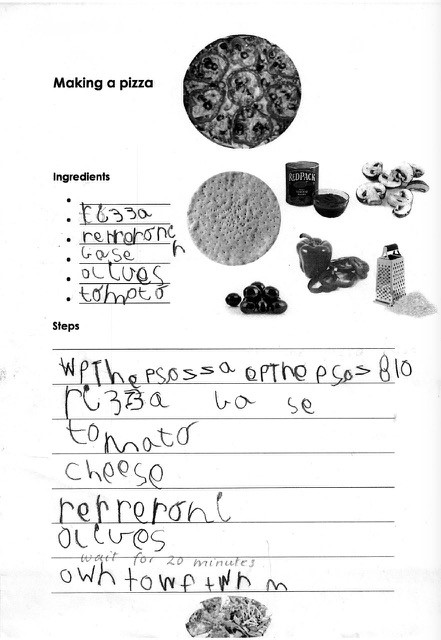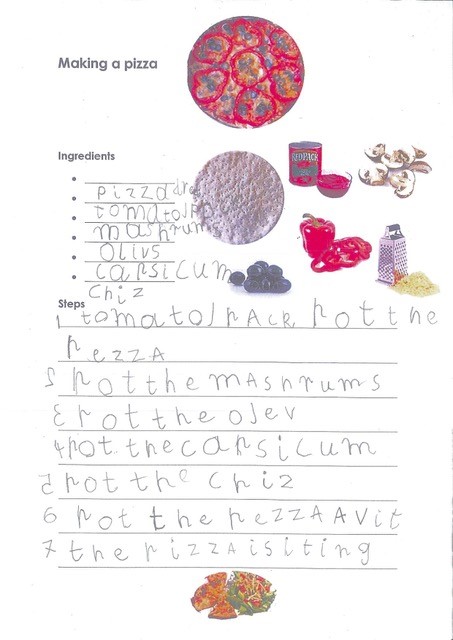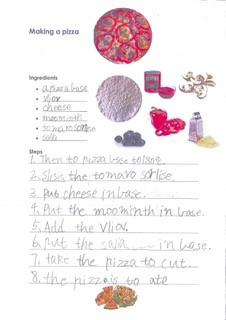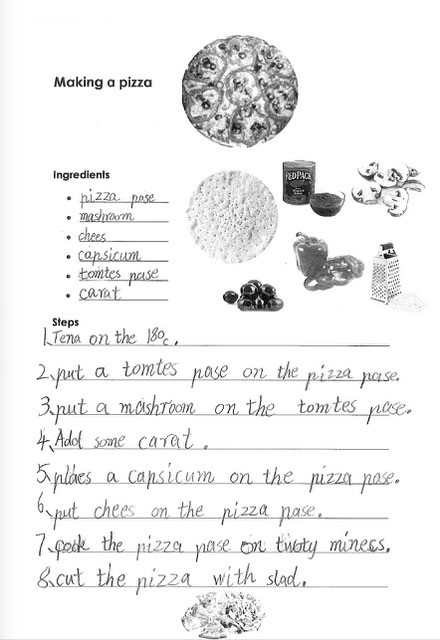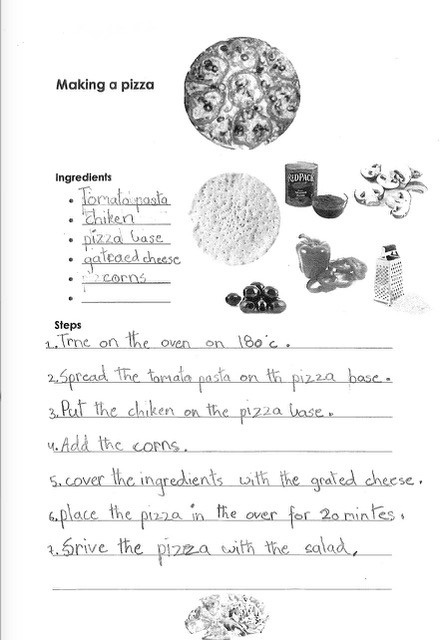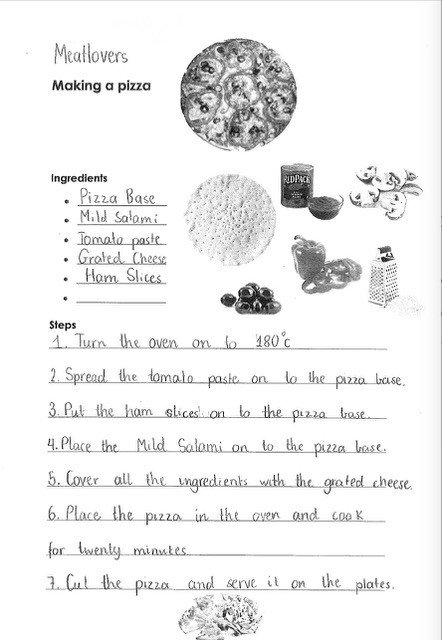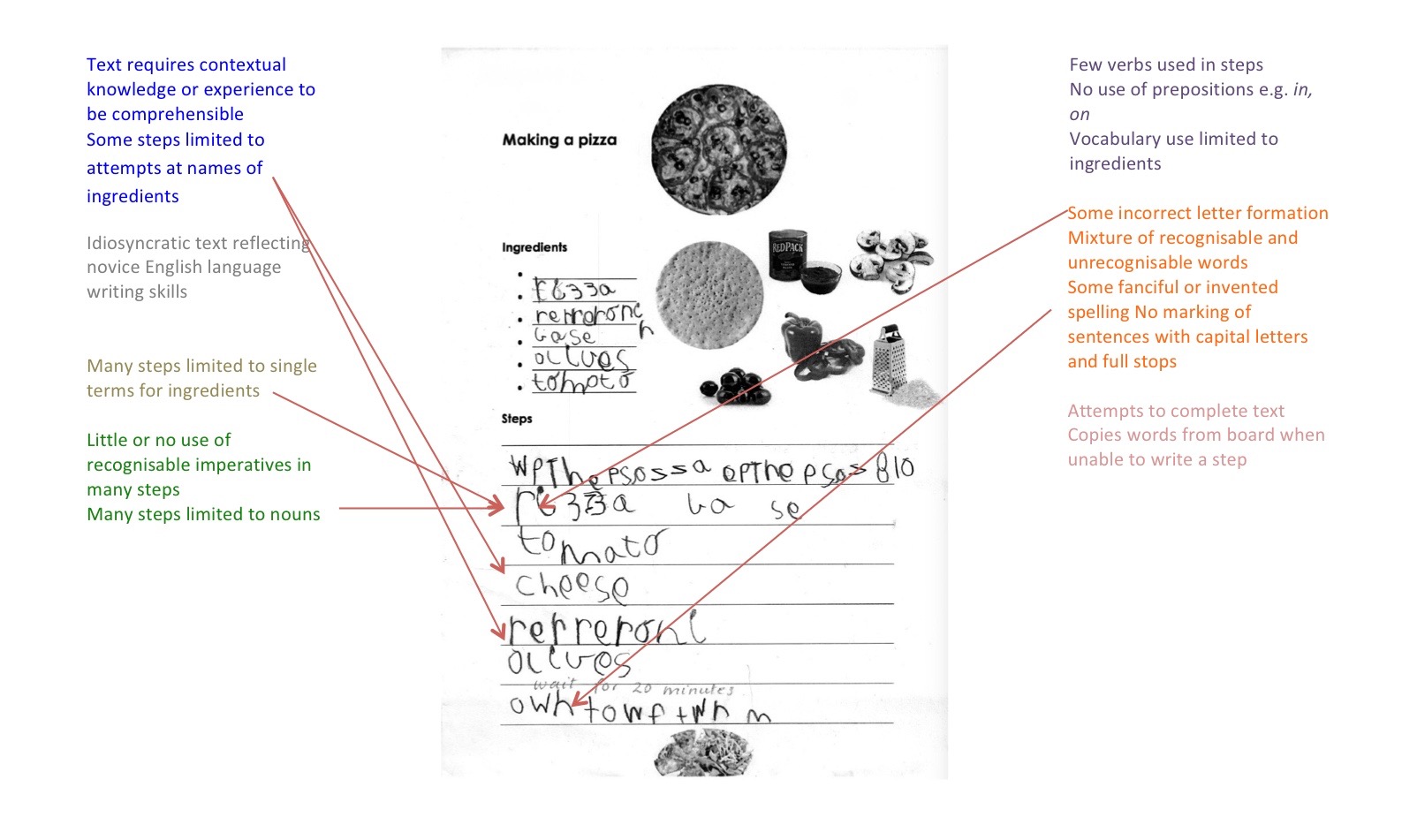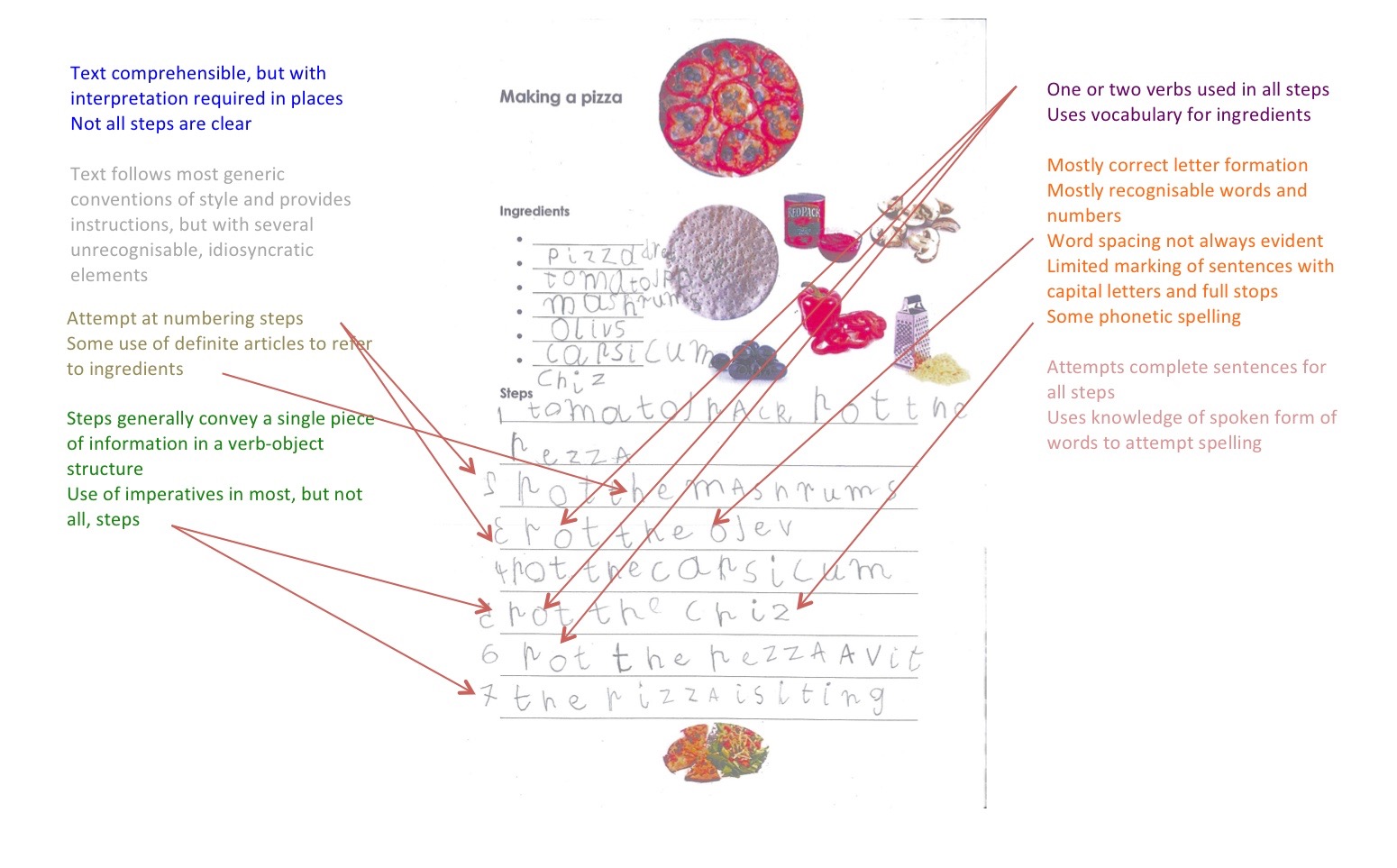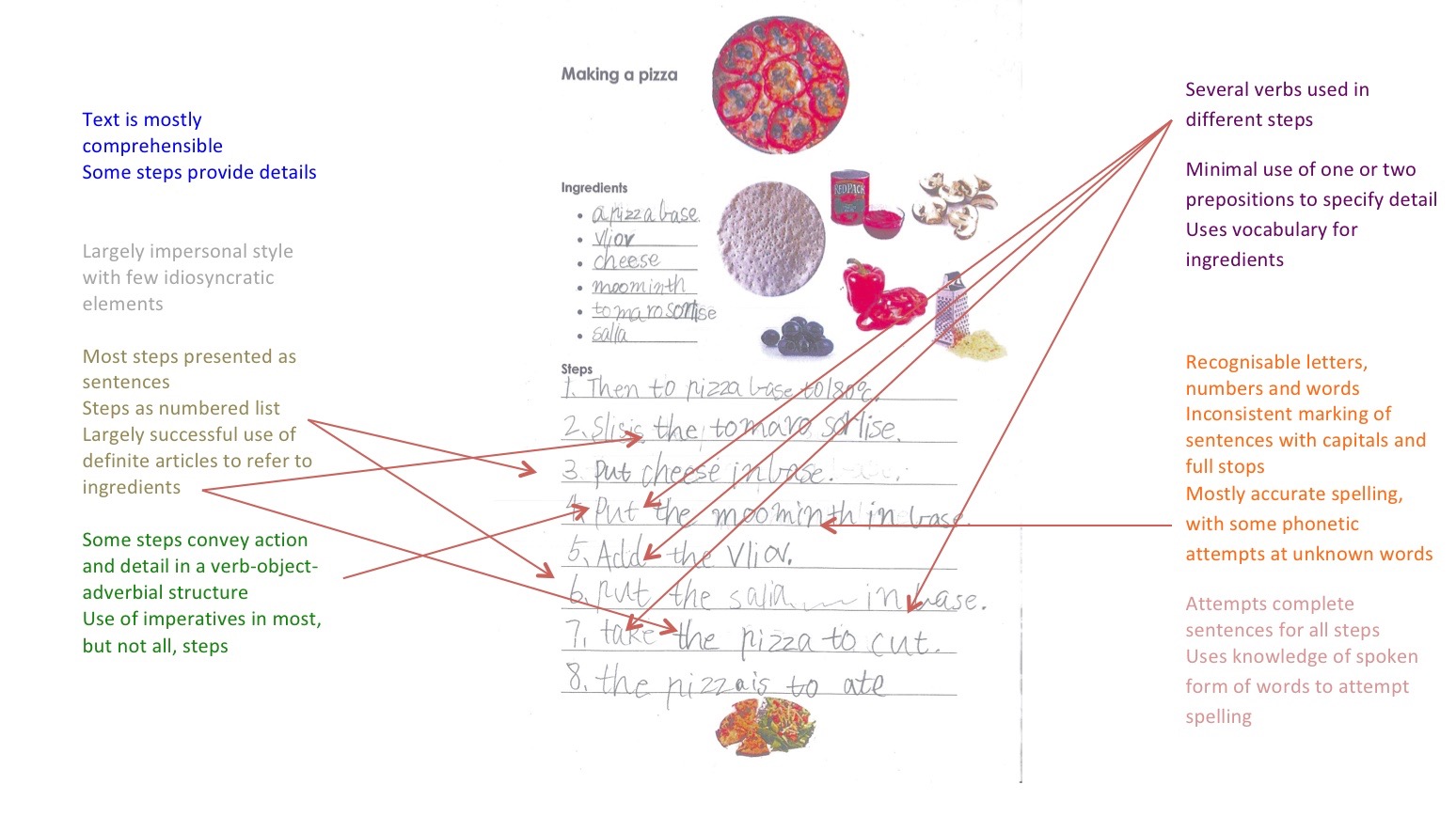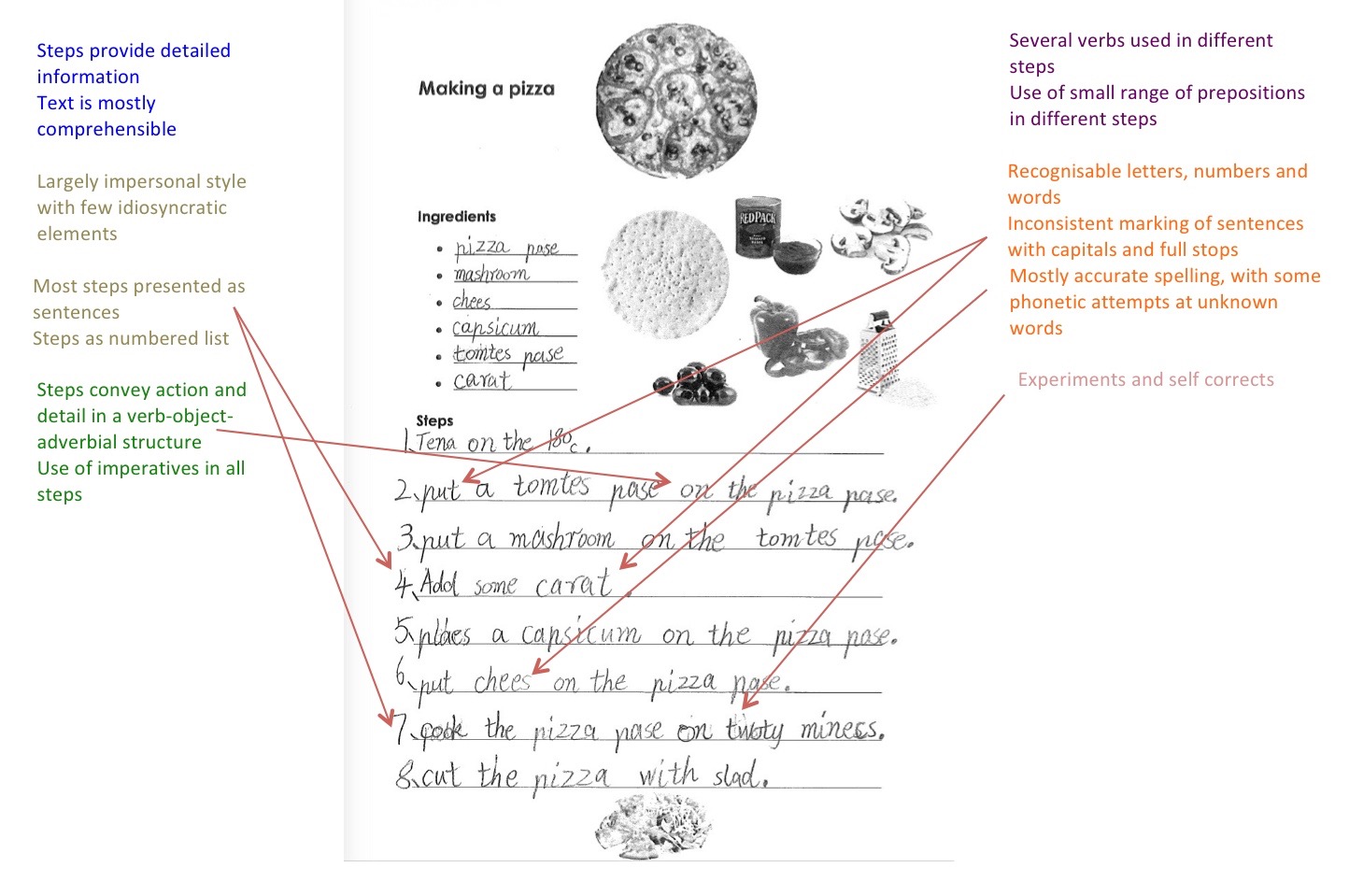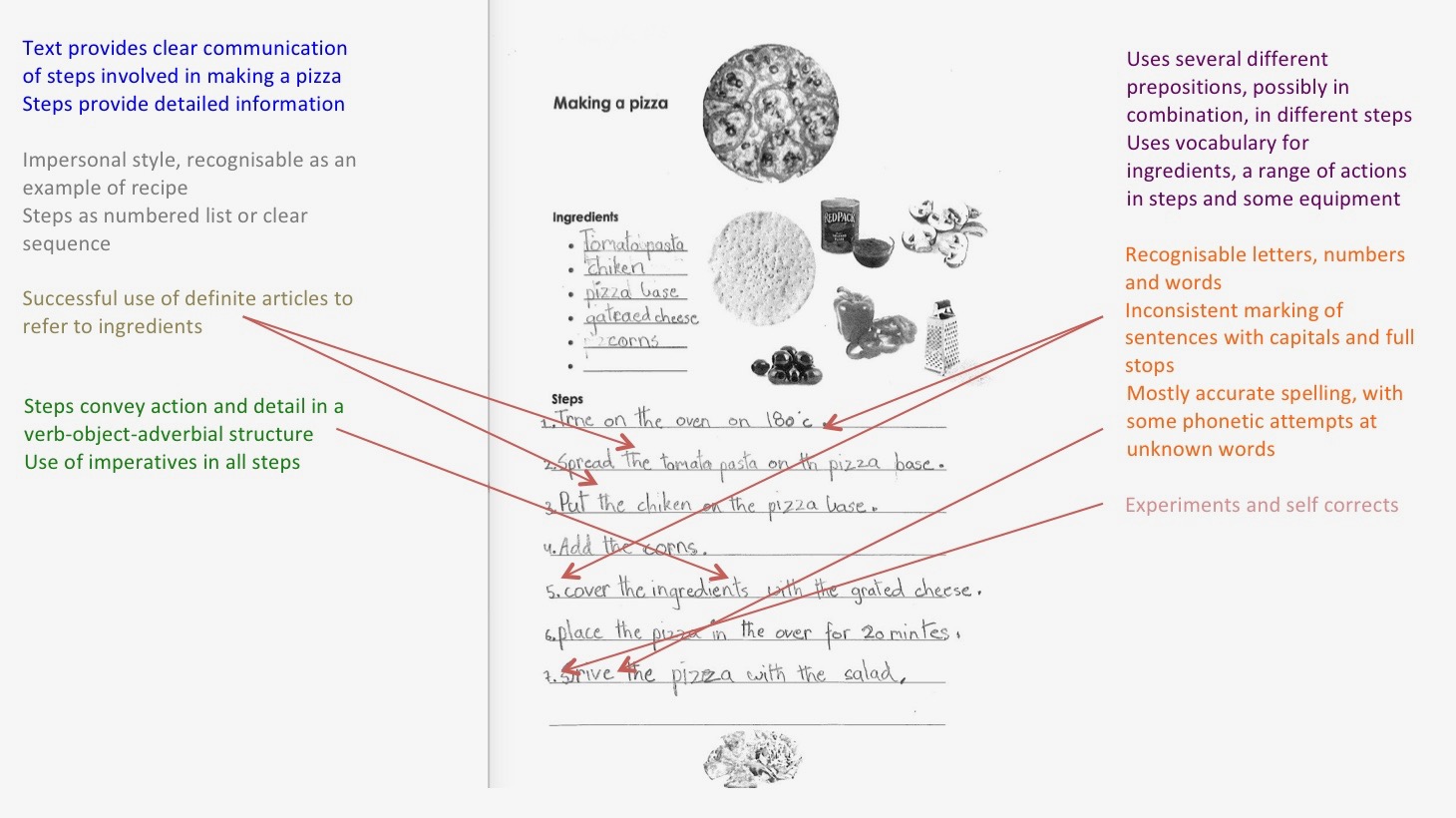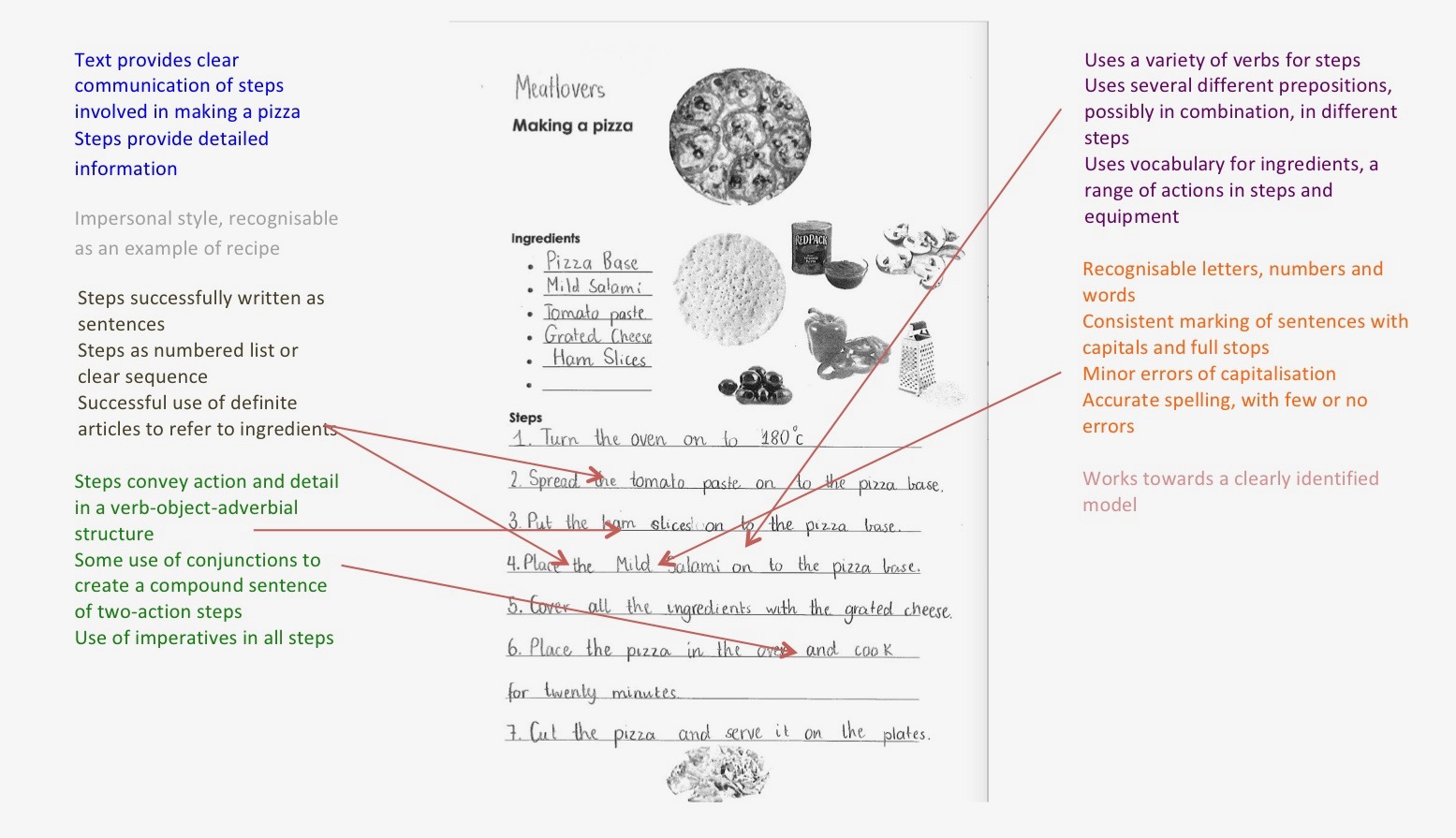13. Making a pizza: text reconstruction
Please click on the toggles below to navigate through information on this assessment task and reveal the links for downloading task materials.
Task details |
|
| Name of writing assessment task | Making a pizza: text reconstruction |
| EAL curriculum level range | A1, A2, BL, B1, B2, CL, C1, C2 |
| Text orientation | Informative |
| Task type | Cued response |
Task specification |
|
| Purpose | To assess students' ability to reconstruct the recipe and text using imperatives and the appropriate vocabulary |
| Description | Students reconstruct the recipe a teacher has presented verbally and in writing |
| Assumed knowledge and description |
|
Learning/teaching context |
|
| Language centre/mainstream class | EAL support |
| Subject/key curriculum objectives, outcomes | English |
| Topic/teaching unit | Food and health |
| Assessment conditions |
|
| Notes |
|
Task implementation |
|
| STAGE | ACTION STEPS |
| Pre-assessment activity |
|
| Assessment activity |
|
| Post-assessment activity |
|
Click here for the unannotated assessment criteria:
- TEAL Writing Task 13–unmarked criteria sheet [PDF]
- TEAL Writing Task 13- unmarked criteria sheet [Word]
An explanation of the purpose, nature and use of criteria sheets is available at 4. Using the assessment criteria.
Purpose and nature of the task
This task focuses on a recipe for a pizza, a food item likely to be familiar to most students. Recipes are also a genre often dealt with in primary and early stage EAL classes. This task relates to other TEAL common assessment task involving procedural texts. These are TEAL Writing Task 4: How to make an origami dog (written instructions), TEAL Oral Task 4: How to make an origami dog (spoken instructions) and TEAL Oral Task 7: Playing a card game (spoken instructions). It is also a real-world text type students may encounter beyond the classroom and school.
As specialised procedural texts, recipes involve certain features, including a tone for a ‘public’ audience. Also prominent are the list format for both ingredients and the steps to be followed, as well as the imperative verb form for giving instructions. There are also vocabulary items for food, equipment used, preparation activities, vocabulary associated with quantities, and the use of prepositions and adverbs to give greater precision to instructions.
However, the task as implemented in these samples provided a strong framework for students completing the task, which narrowed the assessment focus of the task. This is noted in the Text Structure column of the criteria sheet for this task, which omits the formatting of the text as a criterion within the Text Structure because of the way it is provided in the task sheet. The extensive pre-assessment activities also meant that the imperative verb form was not an issue for most of the students who wrote these samples. The task provided greatest assessment focus on the vocabulary used, writing conventions and mechanics, including spelling, and the use of prepositions.
The narrow focus on writing skills and conventions of this task and strong scaffolding make this a suitable task for eliciting information about the development of low-literacy background students at Level BL and CL as well as the English writing skills of EAL students who have developed literacy skills in their first or other languages.
Memory was a significant element of this task for the students producing these samples. Students were asked to write the text after several activities in which they worked with spoken and written forms of the text, and so reconstructing the recipe placed demands on their ability to recall the language used in the pre-assessment activities. This may suggest that errors occurred where the students’ English language knowledge was weakest, as recalling less familiar elements of language was more challenging than remembering words or structures that were very familiar. This illustrates how a challenge in one aspect of language skills or knowledge can provide insight onto other areas of language use. The strategies students use to compensate for a breakdown often provide insights into how other areas of language knowledge are developing. For example, in some of these samples, when students experienced difficulty in recalling the correct spelling of a word they attempted a phonetic spelling, that revealed how their understanding of English graphophonic knowledge was developing.
The narrow focus of this assessment task, involving a highly scaffolded prompt, works like a microscope to provide detailed insight into a relatively small part of the students’ production of this recipe, rather than a broad picture of how they may produce such a text in a more open-ended context. This shows how assessment tasks can be structured in various ways to produce either data on specific dimensions of EAL students’ language use or provide a broader picture of how well students can use and combine language elements to communicate in a specific task and context.
While the first five samples provide useful information to inform teachers about the students’ learning needs, Sample 6 contains few errors. It seems that the task did not extend this student to the limits of her capacity to produce this text, and so the sample does not provide useful data to inform further teaching for this student. This is an example of how assessment that shows what a student is capable of can have limited utility if it fails to extend students to the point where their limits of performance are revealed.
Further samples of student responses to this task are used as a resource for collaborative teacher learning activities in the TEAL Professional Learning module Improving the trustworthiness of assessment.
Contextual information
These samples come from EAL students in classes at a new arrivals program and a mainstream school. Most of the teachers chose a recipe for a vegetarian pizza rather than a ham and pineapple pizza, perhaps for cultural reasons. The samples were the result of following the task implementation instructions, sometimes with some variations. In some classrooms students were invited to write their own recipe rather than using the one provided, and in some lower primary classes important vocabulary items were left on the board while students were writing.
General commentary
The samples present a range of levels of performance of the task. Samples 1, 2 and 3 present the work of EAL students new to literacy or new to literacy in English, while Samples 4, 5 and 6 present the work of more experienced writers writing in their second language. Sample 6 presents an almost error-free piece of writing by an upper primary student, and the student’s teacher noted that the language of this text was superior to the usual level of the student’s spoken English. This reiterates the importance of using multiple assessment tasks in order to build an accurate picture of the overall level of a student’s language skills.
These samples illustrate how phonetic spelling can provide insight into EAL learners’ developing understanding of the graphophonics of English, as well as how EAL students can produce more precise language as they gain control of a wider range of verbs, adverbs and prepositions.
Biographical information:
Year 1
Home language: Arabic
This sample is typical of written texts of EAL students in the early stages of acquiring literacy. It is partly comprehensible due to the strong framework provided by the text format and knowledge of the content of the recipe. However, some parts of the text are very difficult to understand, and the teacher’s gloss (Wait for 20 minutes) is essential to understand the last line.
The text includes words for ingredients but only provides instructions in the first and last steps. The student uses recognisable words for ingredients (pizza, pepperoni, base, olives, tomato, cheese) but letter formation and spelling errors make some of these difficult to recognise. Some letters are not properly formed, especially p which is written the same as r, e sometimes looks like c, p is written entirely above the line and l is smaller than i, making the word olives difficult to recognise. When the student attempts to write instructions the result is difficult to understand. There is some awareness of consonants in wpt for put in the first instruction, and the consonants used in the final line of instructions w, t, f, tw n, m are prominent in the intended sentence (Wait for twenty minutes) although misplacement of these, the almost complete absence of vowels and the presence of some incorrect letters makes this hard to see. Nevertheless, this does show the student is developing an awareness of consonants in the formation of written words and syllables. There is also no capitalisation of letters or punctuation to signal sentences, and there are problems of word spacing. The teacher’s notes for this task reveal that a list of the ingredients was left on the board while the student wrote, so the correct listing of many of the words may be the result of this additional scaffolding, and may also indicate that the student was using copying as a strategy to assist in completion of the text. The notes also report that the student simply decided to write the word for an ingredient when it was too difficult to write the complete step.
The marked criteria sheet shows that the student meets criteria at Level 1 of performance of this task.
The student’s language use in this task is consistent with the descriptions of students at Level A1, Victorian Curriculum F-10 EAL.
TEAL Writing Task 13 – criteria sheet – Sample 1
Using this assessment for further learning
The following teaching priorities emerge from analysis of this text:
- Formation the letters p and r
The student writes these letters identically, meaning that words like pizza and pepperoni appear to be spelt with an r, rather than p.
Two issues needs to be addressed:
- writing p so the body of the letter sits on the line.
- Model the correct writing of p, drawing attention to the need for the round part of the letter to sit on the writing line, and the vertical part to cross the line.
- Give the student practice at writing the letter correctly.
- the distinction between p and r
- Write the word pizza for the student, and ask the student what it says.
- Now ask the student to look at where they have written pizza, and ask if looks the same as what you wrote.
- Point out the problem of the student’s p being written as r.
- Ask the student to correct their spelling of pizza.
- Ask the student to look at pepperoni and point out the same problem, asking the student to correct it.
- Remind the student to write p when needed, and give the student a short list of words to write, with words like put, up, pencil, pizza and pepperoni for further practice, making sure p is written correctly.
- Use of the imperative in an instruction
The student has intended to use a verb in the first and last instructions, but not in the others, which are presented as a list of the items to be added, in order.
- Point out how the student has intended to use verbs at the beginning of the first and last steps. Then tell the student you can’t see what has to be done in these steps, and that an action word is needed.
- Work with the student to identify a model for these steps, such as Put the tomato paste on the pizza base. Write this down if necessary.
- Ask the student to write the instructions for these steps, using the model provided, and monitor his or her work on this.
- Marking of word boundaries.
There are problems of word boundaries and spacing in the sample.
- In completing the task above, using the imperatives, remind the student of the importance of having a space of about 1 or 2 fingers wide between the words written.
- As the student writes, monitor that the student does this.
Biographical information:
Year 1
Home language: Polish
This sample is a recognisable attempt to write the recipe, despite problems like the lack of spaces between words, the lack of capital letters to begin words in the ingredients list and the instruction in each step, and some spelling errors.
The text is appropriately formatted (despite the reversal of some numbers for some of the steps of the procedure) and is generally comprehensible despite a lack of clarity of some words and some instructions, especially Step 1, and a repetitiveness caused by only using put for most of the steps. Except for the first step, the instructions are appropriately formed, with the final step possibly involving the passive form of a verb – the pizza is iting (eaten?). Appropriate subject vocabulary is used, despite some errors: tomato pack for tomato paste, and pizza dred (bread) for pizza base. There are frequent spelling errors, but many of these involve attempted phonetic spelling which renders the intended word recognisable, such as mashrums (mushrooms), olivs and ojev (olives), chiz (cheese) and iting for eaten. The student is making progress on understanding how sounds are represented in writing. Letters are clearly formed and usually recognisable, although p is positioned well above the line, and the numbers 2, 3, and 5 are reversed. There are few spaces to mark word boundaries in the steps, and an absence of capital letters and full stops to mark sentences.
The marked criteria sheet shows that the student meets most criteria at level 2 of performance.
The student’s language use in this task is consistent with the descriptions of students at Level A1, Victorian Curriculum F-10 EAL.
TEAL Writing Task 13 – criteria sheet – Sample 2
Using this assessment for further learning
The following teaching priorities emerge from analysis of this text:
- Letter and number formation
The incorrect placement of the letter p, and reversal of the numbers 2, 3 and 5 are errors that need to be addressed.
- Model the correct writing of p, drawing attention to the need for the round part of the letter to sit on the writing line, and the vertical part to cross the line and finish below the line.
- Give the student practice at writing the letter correctly.
- Ask the student to correct the writing of p on the text.
- Write the numbers 1, 2, 3, 4, 5, 6, 7, 8, and 9.
- Ask the student to look at how you wrote the numbers, then to look at how they are written in the student’s text.
- Ask the student to correct any numbers not written correctly in the text. Point out errors if necessary.
- If further practice is needed, ask the student to write a numbered list of the ingredients used in the pizza.
- Word boundaries
The lack of spaces between words makes the text difficult to read, and will be a problem in other work of the student.
- Ask the student to read Step 2 of the text, pointing to each word as it is said.
- Show the student a step in a recipe with spaces between the words and ask if the sentence written by the student looks like this.
- Point out that spaces need to be left between words, so each word is easy to see.
- Ask the student to re-write Step 2, leaving a space (using one or two fingers or some other concrete measure) between each word. Check this is done correctly.
- Use of capital letters and full stops to mark sentences.
This is a basic writing skill the student needs to master.
- Show the student the sentence for a step in a recipe used in the previous activity. Point out the capital letter at the beginning and full stop at the end.
- Ask the student to look at Step 2 in their text, and point the capital letter and full stop.
- Ask the student to re-write Step 2 using a capital letter and full stop.
- Then ask the student to re-write Steps 3, 4, 5, and 6 leaving spaces between words, making sure p is written correctly and capital letters and full stops are used.
Biographical information:
Year 3
Home language: Mandarin
This sample is a well formatted and mainly comprehensible text despite problems in some steps (1, 2 and 8), and spelling errors that make some words hard to recognise. The writing is clear and letters are easy to identify, and despite the lack of capital letters at the beginning of words in the list of ingredients, it is well formatted with clearly presented and numbered steps. A variety of imperative verbs is used, put, add, and take. However, the first step does not begin with an imperative verb, and refers to both the pizza base and temperature so the meaning is unclear. Step 2 is also difficult as it is not clear what is meant to be done with the tomato paste (written as tomato sorlise – sauce?). Perhaps slisis is an attempt to write spread, although it seems to resemble slice, which would not make sense. The student tries to use more complex and interesting constructions for Steps 7 and 8. However, Step 8 is incomplete, with ready omitted, but is a good attempt at a final sentence for the recipe. A preposition is attempted, but the wrong one is chosen, in base being used for on (the) base. Some topic vocabulary is used and spelt correctly, but while most of the incorrect spelling is recognisable either by some resemblance to the shape of the intended word (vliov for olive, moonminth for mushroom, sorlise for sauce, slisis for slice?), salia is not so recognisable. Perhaps it is an attempt at salami. Numbers, capital letters and full stops are used correctly in most but not all cases, and words are spaced out and recognisable. Capital letters are missing in the list of ingredients and the last three steps, and all steps except the final one end with full stops.
The marked criteria sheet shows that the student meets most criteria at Level 3 of performance.
The student’s language use in this task is consistent with the descriptions of students at Level B1, Victorian Curriculum F-10 EAL.
TEAL Writing Task 13 – criteria sheet – Sample 3
Using this assessment for further learning
The following teaching priorities emerge from analysis of this text:
- Unclear construction of steps in a recipe
The first two steps and Step 8 are difficult to understand due to problems of structure and meaning.
- Ask the student to read Step 1, and ask the student to explain what it means.
- Ask the student how to say this more clearly. If the student provides an acceptable instruction, ask the student to write what was said to replace Step 1 in their text. If necessary, provide a model for the student to write, such as Turn on the oven to 180 degrees.
- Repeat this procedure for Step 2, but work with a model like Spread the tomato paste on the pizza base.
- Ask the student to look at Step 8, and show how ready to eat can be used to end the sentence.
- Spelling of topic vocabulary
The student makes quite a few errors in spelling topic vocabulary, making some words very difficult to recognise.
- Make a list of the words spelt incorrectly in the text, using the correct spelling. It may be necessary to check the intended meaning of the word written as salia.
- Ask the student to match the words on the list with what was written in the text, and re-write each word correctly.
- Consistent use of capital letters and full stops
While the student uses these correctly most of the time, there are still some errors.
- Praise the student for correct use of capital letters and full stops, and point out some correct use of these.
- Ask the student to compare these with Steps 6, 7 and 8, and make corrections, so that they begin with capital letters and end with full stops.
Biographical information:
Year 4
Home language: Mandarin
This sample is recognisable as a recipe and is comprehensible despite some errors of structure, spelling and punctuation. Each step begins with a relevant imperative, using a range of relevant words put, Add, cook and cut, although an error is made with places. Most steps specify an ingredient and use the preposition on to add detail to the action, such as, put chees on the pizza pase. On is the main preposition used, and is incorrectly used with reference to the time to cook the pizza in Step 7. With is used, but incorrectly in the final step. The first step omits the object of the verb, the oven, and the preposition to for the temperature, but the other steps are structured appropriately. While the definite article the, and some are used appropriately, there are problems in relation to pluralisation and the articles or determiner used with some ingredients. The tomato (written as tomates) of tamates paste is pluralised in both the list of ingredients and where it is used in Steps 2 and 3, and mashroom (mushroom) and capsicum are written in the singular, preceded by a, where they would usually be plural and preceded by some or the, as in Put some (or the) mushrooms on…. Some is used appropriately before carat (carrot) as would usually be the case. Topic vocabulary is used appropriately. However, there are several spelling errors. These are largely phonetic, chees for cheese, carat for carrot, pase for paste and also for base, minecs for minutes, mashroom for mushroom, slad for salad, while some have a visual resemblance to the intended word, tena for turn, twoty for twenty or tomtes for tomato. All steps end with a full stop, but capital letters are used inconsistently at the beginning of steps with most steps beginning with lower case letters.
The marked criteria sheet shows that the student meets most criteria at Level 3 of performance.
The student’s language use in this task is consistent with the descriptions of students at Level B1, Victorian Curriculum F-10 EAL.
TEAL Writing Task 13 – criteria sheet – Sample 4
Using this assessment for further learning
The following teaching priorities emerge from analysis of this text:
- Capital letters
Not beginning steps with capital letters is a major punctuation error that will lead to negative assessment of the student’s work in other contexts.
- Point to where the student has successfully begun steps with a capital letter, and praise the student for this.
- Point to the other steps, and ask the student why capital letters weren’t used. Remind the student of the importance of beginning sentences, including steps in recipes, with a capital letter.
- Discuss where else capital letters should be used, such as the beginnings of words in the list of ingredients
- Instruct the student to make corrections on the text.
- Countable/non-countable nouns and appropriate determiners
The student’s errors of pluralisation and determiners suggest the student is a little confused about this rather complex but basic element of English.
- Review the list of ingredients, and which items can be made plural by adding s (mushroom/s, carrot/s, capsicum/s, pizza/s), and which can’t (tomato paste, and cheese).
- Explain that in a recipe the is often used for plural ingredients, because the ingredients have already been mentioned in the list of ingredients. Some can be used for things that can’t be counted, like water or cheese, and a or an can be used to mean just one, as in this example:
Icy pole recipe
| Ingredients | Steps |
|
Orange juice (1 cup) Water (1 cup) Sugar Icy pole sticks (4) Icy pole tray |
Makes 4 icy poles |
Ask the student to look again at the text, and put the words for the ingredients and equipment in their recipe in this table. One example of each is given:
| a, an | the | some |
| pizza base | mushrooms | tomato paste |
Spelling of content vocabulary
The student makes quite a few errors in spelling important content words.
- Make a list of the words spelt incorrectly in the text, using the correct spelling.
- Ask the student to match the words on the list with what was written in the text, and re-write each word correctly.
- Ask the student to re-write the text, making sure to use capital letters, a, the and some, adding s to the ingredient words that need it, and spelling the words for the ingredients correctly.
Biographical information:
Year 4
Home language: Hindi
This sample uses a wider range of vocabulary and structures to provide more detail, such as Spread the tomato pasta (paste) on the pizza base. Most steps are constructed appropriately, such as Put the chiken (chicken) on the pizza base. The text looks competent, despite some errors of spelling and grammar. The text ends with a closing step of serving the pizza with salad. A range of verbs is used in the steps, and several prepositions, in, with, and for are used to give detail. Most words are spelt correctly, however, there are still some spelling errors, pasta for paste, gatraed for grated (though this is correct in Step 5), Trne for turn and Srive for Serve. Corns is incorrectly pluralised and, while most steps begin with a capital letter, two do not. Only the first ingredient in the list begins with a capital letter.
The marked criteria sheet shows that the student meets most criteria at Level 4, with some at Level 3 of performance.
The student’s language use in this task is consistent with the descriptions of students at Level B2, Victorian Curriculum F-10 EAL.
TEAL Writing Task 13 – criteria sheet- Sample 5
Using this assessment for further learning
The following teaching priorities emerge from analysis of this text:
- Consistent use of capital letters
Inconsistencies of capitalisation detract from the authority of the text, and this punctuation error can lead to negative judgements about a student’s work.
- Point to where the student has successfully began steps with a capital letter, and praise the student for this.
- Point to the other steps, and ask the student why capital letters weren’t used. Remind the student of the importance of beginning sentences, including steps in recipes, with a capital letter.
- Discuss where else capital letters should be used, such as the beginnings of words in the list of ingredients.
- Instruct the student to make corrections on the text.
- Spelling
- Ask the student to look at the text and underline any words the student knows or thinks might be incorrectly spelt.
- Check the words marked by the student, and point out any incorrectly spelt words that are not marked.
- Ask the student to correct the spelling of the words they have underlined. Provide assistance when the student does not know the correct spelling of a word.
- Plurals of countable and non-countable nouns.
While the error with corns is relatively minor in this context, this area of English can be problematic for EAL learners, and such errors can lead to negative judgements about EAL students’ levels of English.
- Point out that the student has written corns, but that this is a word that we can’t make plural by adding s.
- Explain that things we can easily count and use numbers to identify, like mushroom (3 mushrooms) and pizza (2 pizzas)*, are made plural by adding s, but things we can’t count, like water, tomato paste and cheese, can’t be made plural by adding s. These are written without the s, even when a large amount that thing is referred to, for example, a lot of water (not waters). Point out corn is a word like this.
* Pizza can also be a non-countable noun in some contexts, such as in We’re having pizza and salad at the party.
- Ask the student to complete this table with words for the ingredients from the recipe:
| Things that are easy to count | Things that are hard to count |
| Add 's' when talking about more than one | Don’t add 's' |
|
|
- Check what the student writes for the items from the recipe.
- Ask the student to add some other words they can think of that fit in each column.
Biographical information:
Year 5
Home language: Vietnamese
This sample follows correct conventions of the recipe genre, with only a few errors of inappropriate capitalisation of some words. The format and style of the text is appropriate, and a clear sequence of instructions is provided. A variety of verbs is used which adds interest to the text, prepositions are correctly used to give clarity and detail, and the final sentences use and to create compound sentences, reducing the repetitiveness of the text. The writing of on to as separate words is acceptable, although many writers would use a single word onto in this context.
As mentioned in the general annotation for this task, the teacher noted that the language of this text is better than the student’s oral language at the time the text was written. The teacher also observed that the student kept her text very close to the model that had been provided, a strategy, possibly involving memorisation, that probably helped her to reduce the risk of making errors.
The marked criteria sheet shows that the student meets criteria at level 4 of performance.
The student’s language use in this task is consistent with the descriptions of students at level B2, Victorian Curriculum F-10 EAL.
TEAL Writing Task 13 – criteria sheet- Sample 6
Using this assessment for further learning
This sample provides little data to inform further learning, as the task did not challenge the student to the point where many errors were made.
- Errors of capitalisation
The student inappropriately used capital letters for the second words in the list of ingredients, and with the words Mild Salami in Step 4.
- Point out that capital letters are only used at the beginning of the first word for items in a list, and at the beginning of sentences.
- Ask the student to review the text, and correct where a capital letter has been incorrectly used.
- On to or onto?
While using separate words for this preposition is not formally incorrect, a single word would often be used in this context that implies movement.
- Explain to the student that it is possible to also write onto as a single word when the actual movement of something is being described, in the same way as into can be used.

